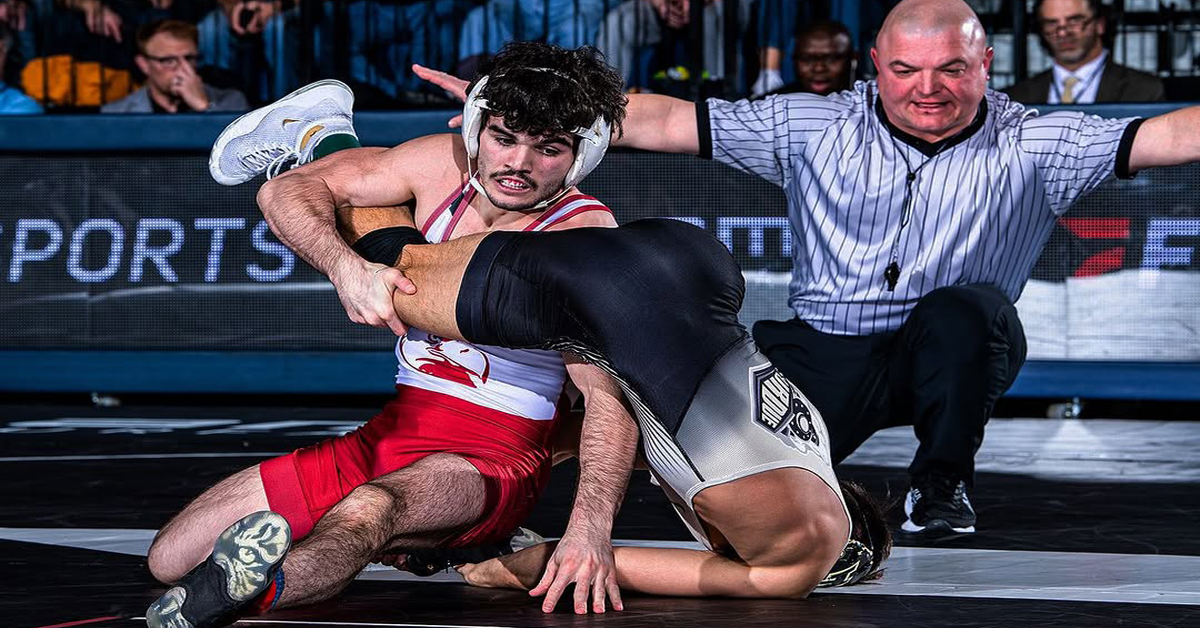Chain Wrestling

In every form of wrestling, all of the techniques are connected together through chain wrestling. These connections are what make the link from getting an opponent to the ground and into a pinning position.
Below are fifty examples of chain wrestling, with descriptions provided. Check out these chain wrestling techniques and be sure to add any to your arsenal that you may not know.
What is Chain Wrestling?

Chain wrestling is the connecting of different techniques for the goal of landing a takedown, pin, or submission. There are nearly infinite examples of chain wrestling, with variations taught by different coaches.
Standing Transitions
Many chain wrestling transitions begin from stranding and connect techniques in order to secure a takedown. Here are ten examples of stranding transitions using chain wrestling.
1. Collar-and-Elbow Tie-Up to Arm Drag
An arm drag is a common setup from a collar-and-elbow tie-up. Take your collar tie hand off your opponent’s neck and grab above their elbow as you step in.
2. Duck Under to Back Control
From a bicep control, raise your opponent’s arm up to give you space to duck under and go to their back.
3. Snap Down to Front Headlock
Using a collar tie, break your opponent’s posture by snapping their head down and secure a front headlock.
4. Arm Drag to Single-Leg Takedown
One of the many transitions from an arm drag is to a basic single-leg takedown. As you step into your arm drag, change levels, and grab a single leg on your opponent.
5. Russian Tie to Fireman’s Carry
When your opponent goes for a collar tie, counter the grab with a Russian tie. With both hands controlling their arm, take one grip off, dive between their legs, and secure the fireman’s carry.
6. Double-Leg Takedown to Bodylock
In case of an opponent sprawling your double-leg, fake the attempt and come up into a bodylock.
7. Waist Lock to Standing Switch
When your opponent has a back waist lock, counter the grip by exploding up and counter into a standing switch.
8. Head-and Arm Tie-Up to Arm Spin
From a collar tie, fake a single-leg on your opponent to set up an arm spin and go to their back.
9. Shuck to Side Body Lock
When you attempt a go behind transition, your opponent will often follow you. In this case, use a shuck to throw their head to the side and take a side body lock.
10. Snap Down to Go-Behind
From head-and-arm control, snap your opponent down and go behind their back.
Ground Transitions
11. Single-Leg Takedown to Ankle Pick
From a collar-tie, a single leg set up is common, but your opponent might take their front leg away. If they do that, you can go to a nice ankle pick on the opposite side.
12. Front Headlock to Cradle
Front headlock to any cradle variation you like, from the inside of outside depending on the situation.
13. Switch Armbar Half Nelson
Use an armbar to break down your opponent’s posture as you switch to a half nelson for a pin attempt.
14. Knee Tap to Side Control
From an underhook, pull your opponent forward to hit the knee tap and land in side-control.
15. Sprawl to Back Control
Sprawl on top of your opponent as they come in for a takedown attempt and transition around to back control.
16. Cross Wrist Release to Cross Face Cradle
Let go of a cross wrist grip to hit a cross face cradle variation.
17. Snap Down to Gut Wrench
Snap your opponent’s head down, rotate to their side, grab a bodylock, and roll into a gut wrench.
18. Hip Heist Escape From Tight Waist
A hip heist escape is the most common escape from when your opponent has a tight waist.
19. Granby to Peterson Roll
Escape out of a tight waist lock using a Granby roll and transitioning into a Peterson roll.
20. Leg Ride to Power Half-Nelson
Leg riding and transitioning your opponent to their back using a power half-nelson.
Submission Transitions(Submission Wrestling)

Chain wrestling becomes even more diverse once submissions are added to the equation. Here are some examples of chains from submission wrestling.
21. Side-Control to Kimura Lock(Double Wrist Lock)
In side-control-isolate your opponents far arm and lock-on a kimura or double wrist lock.
22. Side-Control to Arm Triangle Choke
From side-control, push your opponent’s far arm across their neck as you lock your hands together. Hop to the other side, sprawl to the mat, and lock in your submission.
23. Front Head Control to Guillotine Choke
Snap your opponent’s head down into front head control, and lock in a guillotine choke.
24. Single-Leg Attempt to Heel Hook
Fake a single-leg takedown attempt and fall back on your opponent’s leg and lock in a heel hook.
25. Arm Drag to Rear Naked Choke
Use an arm drag to get all the way to your opponent’s back and lock in a rear naked choke.
26. Mount to Armbar
From the mount, hug your opponent’s arm to your chest and transition into an armlock.
27. Mount to Triangle Choke
From the mount, control both of your opponent’s arms. Push one arm to their chest as you bring your leg up and lift their neck off their mat. Triangle your legs together and either stay mounted or go to your back.
28. Americana to Arm Triangle
Your opponent may react to an Americana attempt by keeping their arm in tight. If they defend this way, use the opportunity to set up an arm triangle submission.
29. Guillotine Choke to Anaconda Choke
If your opponent defends your guillotine attempt, use it as a setup to go into a tight anaconda choke.
30. Triangle Choke to Omoplata
If your opponent is defending your triangle choke attempt by hooking their arm around your leg, use this to hit an omoplata.
Reversal and Counter Transitions

There’s a whole other set of chain wrestling maneuvers to either reverse or counter out of a bad spot. Here are ten examples of these moves.
31. Granby Roll to Escape
Just like mentioned above, you can Granby roll to roll out of a tight waist grab.
32. Exploding Sit Out Switch
When your opponent is chasing you, a normal sit out may not work. Another option is a exploding variation where you shoot your hips forward before going into your switch,
33. The Hurdler
When your opponent is on top with a leg ride, straighten your leg, and pivot hard into your opponent.






